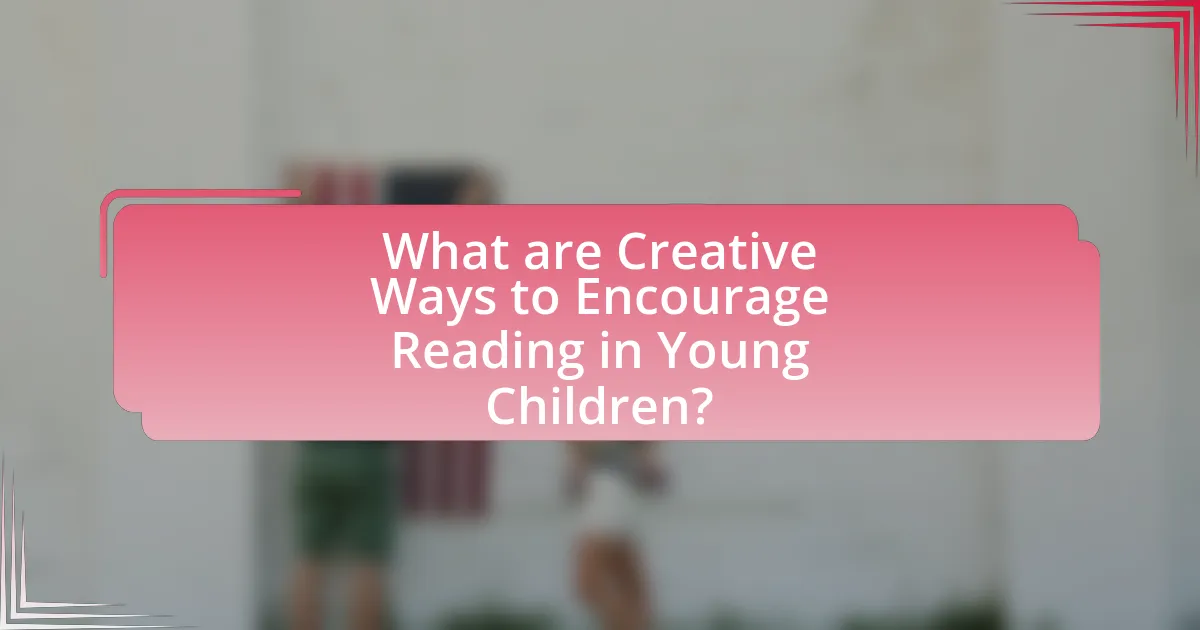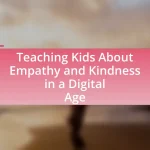The article focuses on creative ways to encourage reading in young children, emphasizing the importance of early reading for cognitive and emotional development. It outlines various strategies such as interactive storytelling, creating inviting reading spaces, and utilizing technology like audiobooks and e-books to engage children. The article also discusses the cognitive benefits of early reading, including vocabulary development and improved comprehension, as well as the role of parents, educators, and community initiatives in fostering a love for reading. Additionally, it highlights practical tips for parents to incorporate reading into daily routines and model positive reading behaviors.

What are Creative Ways to Encourage Reading in Young Children?
Creative ways to encourage reading in young children include interactive storytelling, creating a reading nook, and incorporating technology like audiobooks. Interactive storytelling engages children by allowing them to participate in the narrative, which enhances comprehension and retention. A dedicated reading nook provides a cozy and inviting space that promotes a positive reading environment, making children more likely to choose books over screens. Additionally, using audiobooks can introduce children to new stories and vocabulary, fostering a love for literature while accommodating different learning styles. These methods are supported by research indicating that interactive and engaging reading experiences significantly improve literacy skills in early childhood.
Why is it important to encourage reading at a young age?
Encouraging reading at a young age is crucial because it significantly enhances cognitive development and literacy skills. Research indicates that children who engage in reading early on develop better vocabulary, comprehension, and critical thinking abilities. For instance, a study by the National Institute for Literacy found that children who are read to regularly from infancy have a higher likelihood of achieving reading proficiency by third grade, which is a key predictor of future academic success. Additionally, early reading fosters a love for literature, promoting lifelong learning and curiosity.
What cognitive benefits does early reading provide?
Early reading provides significant cognitive benefits, including enhanced vocabulary development, improved comprehension skills, and better critical thinking abilities. Research indicates that children who engage in reading at an early age tend to have a larger vocabulary by the time they enter school, which correlates with their overall academic success. A study published in the journal “Child Development” by authors Christopher J. Lonigan and Susan A. Phillips found that early exposure to reading materials fosters language skills and cognitive development, leading to improved literacy outcomes. Additionally, early readers demonstrate stronger problem-solving skills and the ability to analyze information, which are crucial for academic achievement and lifelong learning.
How does reading influence emotional development in children?
Reading significantly influences emotional development in children by enhancing their empathy and emotional intelligence. Engaging with diverse characters and narratives allows children to understand and relate to different emotions and perspectives, fostering their ability to empathize with others. Research indicates that children who read regularly demonstrate improved emotional regulation and social skills, as they learn to navigate complex emotional situations through the experiences of characters in stories. For instance, a study published in the journal “Child Development” found that children who read fiction showed greater empathy and understanding of social cues compared to those who did not. This connection between reading and emotional development underscores the importance of encouraging reading as a means to support children’s emotional growth.
What are some innovative strategies to promote reading?
Innovative strategies to promote reading include integrating technology, such as interactive e-books and reading apps, which engage children through multimedia elements. Research indicates that children who use interactive reading apps show improved literacy skills compared to traditional reading methods. Additionally, organizing community reading events, like read-a-thons or book fairs, fosters a social environment that encourages reading among peers. Studies have shown that social interactions around reading can significantly enhance children’s motivation to read. Implementing reading challenges with rewards can also stimulate interest; for instance, programs that track reading progress and offer incentives have been effective in increasing reading frequency among young readers.
How can storytelling enhance a child’s interest in books?
Storytelling enhances a child’s interest in books by making narratives engaging and relatable, which fosters a love for reading. When children hear stories, they experience emotional connections to characters and plots, stimulating their imagination and curiosity. Research indicates that storytelling can improve language skills and comprehension, as children learn new vocabulary and concepts through context. For instance, a study published in the Journal of Educational Psychology found that children exposed to storytelling showed a 30% increase in vocabulary acquisition compared to those who were not. This interactive experience not only captivates their attention but also encourages them to explore books independently, as they seek to recreate the enjoyment they found in storytelling.
What role do interactive reading sessions play in engagement?
Interactive reading sessions significantly enhance engagement by actively involving children in the reading process. These sessions encourage participation through questions, discussions, and interactive elements, which help maintain children’s interest and foster a deeper understanding of the material. Research indicates that children who participate in interactive reading sessions demonstrate improved vocabulary and comprehension skills, as they are more likely to connect with the story and express their thoughts. For instance, a study published in the Journal of Educational Psychology found that children who engaged in interactive reading showed a 30% increase in story recall compared to those who experienced traditional reading methods. This evidence underscores the effectiveness of interactive reading sessions in promoting engagement among young readers.
How can parents and educators create a reading-friendly environment?
Parents and educators can create a reading-friendly environment by establishing dedicated reading spaces that are comfortable and well-stocked with diverse books. Research indicates that children who have access to a variety of reading materials are more likely to develop a love for reading; for instance, a study by the National Endowment for the Arts found that children with access to books at home are more likely to read for pleasure. Additionally, incorporating regular reading routines, such as daily storytime, fosters a habit of reading and enhances literacy skills. Creating a visually appealing space with cozy seating, good lighting, and colorful decorations can further stimulate interest in reading.
What types of reading materials should be available for young children?
Young children should have access to a variety of reading materials, including picture books, board books, early readers, and interactive books. Picture books, which often feature colorful illustrations and simple text, help develop visual literacy and comprehension skills. Board books, designed for durability, are ideal for toddlers who may handle books roughly. Early readers, with their controlled vocabulary and sentence structure, support the transition to independent reading. Interactive books, which may include flaps, textures, or sounds, engage children’s senses and encourage participation. Research indicates that diverse reading materials enhance language development and foster a love for reading in young children, as supported by studies from the American Academy of Pediatrics.
How can the physical space be designed to encourage reading?
The physical space can be designed to encourage reading by incorporating comfortable seating, adequate lighting, and accessible bookshelves. Comfortable seating areas, such as bean bags or cushioned chairs, create inviting spots for children to settle down with a book. Adequate lighting, including natural light and soft artificial lighting, enhances visibility and reduces eye strain, making reading more enjoyable. Accessible bookshelves, organized by age and interest, allow children to easily find and select books that appeal to them, fostering a sense of independence and choice in their reading habits. Research indicates that environments tailored to children’s needs significantly increase their engagement with reading materials, promoting literacy development.
What are some community-based initiatives to support reading?
Community-based initiatives to support reading include programs like “Reading Partners,” which pairs volunteers with children to improve literacy skills through one-on-one tutoring. Another initiative is “Little Free Libraries,” which encourages communities to set up small, free book exchanges to promote access to books. Additionally, “Bookmobile” services deliver books directly to underserved neighborhoods, ensuring that children have access to reading materials. Research shows that such initiatives can significantly enhance literacy rates; for instance, a study by the National Assessment of Educational Progress found that children who engage with community reading programs show improved reading proficiency compared to those who do not participate.
How can libraries contribute to fostering a love for reading?
Libraries can foster a love for reading by providing access to a diverse range of books and hosting engaging programs. By offering a variety of genres and reading materials, libraries cater to different interests and reading levels, which encourages children to explore and discover new stories. Programs such as storytime sessions, reading clubs, and author visits create interactive experiences that make reading enjoyable and social. Research from the American Library Association indicates that children who participate in library programs show increased reading skills and a greater interest in reading overall.
What programs can schools implement to encourage reading outside the classroom?
Schools can implement reading incentive programs, such as summer reading challenges, to encourage reading outside the classroom. These programs motivate students by offering rewards for completing reading goals, which has been shown to increase engagement and literacy skills. For instance, a study by the National Summer Learning Association found that students who participate in summer reading programs can maintain or improve their reading levels, countering the “summer slide” effect. Additionally, schools can establish book clubs or reading partnerships with local libraries, providing students with access to a wider range of books and fostering a community around reading.
How can technology be utilized to promote reading among young children?
Technology can be utilized to promote reading among young children through interactive e-books and educational apps that engage them with multimedia content. These digital resources often incorporate animations, sound effects, and interactive elements that make reading more appealing and enjoyable for young learners. Research indicates that children who use e-books with interactive features show improved comprehension and retention of stories compared to traditional print books. For instance, a study published in the Journal of Educational Psychology found that children who engaged with interactive e-books demonstrated a 30% increase in story recall. This evidence supports the effectiveness of technology in fostering a love for reading among young children.
What are the benefits of using e-books and reading apps?
E-books and reading apps offer several benefits that enhance the reading experience for young children. They provide interactive features such as animations, audio narration, and touch-responsive elements that engage children more effectively than traditional print books. Research indicates that interactive e-books can improve comprehension and retention of information, as children are more likely to stay focused and interested when using these digital formats. Additionally, e-books often include adjustable text sizes and background colors, which can accommodate various reading levels and preferences, making reading more accessible. Furthermore, the portability of e-books allows children to carry multiple titles in one device, encouraging a habit of reading anytime and anywhere.
How can educational games enhance reading skills?
Educational games can enhance reading skills by providing interactive and engaging experiences that promote literacy development. These games often incorporate phonics, vocabulary building, and comprehension exercises, making learning enjoyable and effective. For instance, research by the Joan Ganz Cooney Center found that children who played educational games showed significant improvement in their reading abilities compared to those who did not engage with such tools. This improvement is attributed to the games’ ability to reinforce learning through repetition and immediate feedback, which are crucial for mastering reading skills.
What are some practical tips for parents to encourage reading at home?
Parents can encourage reading at home by creating a dedicated reading space and establishing a daily reading routine. A comfortable, quiet area filled with books can make reading more inviting, while setting aside specific times each day for reading helps to build a habit. Research indicates that children who read regularly develop better literacy skills; for instance, a study by the National Institute for Literacy found that children who read daily are more likely to perform better academically. Additionally, parents can engage in reading together, discussing stories and asking questions to enhance comprehension and interest.
How can parents model reading behavior for their children?
Parents can model reading behavior for their children by consistently engaging in reading activities themselves. When parents read regularly, whether books, magazines, or articles, they demonstrate the value and enjoyment of reading. Research indicates that children whose parents read frequently are more likely to develop strong reading habits and skills. For instance, a study published in the journal “Reading Research Quarterly” found that children who observed their parents reading were more likely to view reading as a positive and rewarding activity, leading to increased literacy development. By creating a reading-rich environment and sharing their reading experiences, parents effectively encourage their children to adopt similar behaviors.
What daily routines can incorporate reading into family life?
Daily routines that can incorporate reading into family life include setting aside specific times for family reading sessions, such as during breakfast or before bedtime. These routines create a consistent environment where reading becomes a shared activity, fostering a love for books among children. Research indicates that children who engage in regular reading with family members develop better literacy skills and a greater interest in reading overall. For instance, a study by the National Institute for Literacy found that children who are read to daily are more likely to perform better in school.















